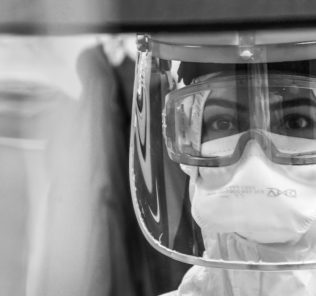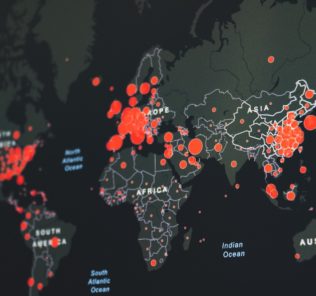Coronavirus Simulation Resources: Scenarios, Online Training, Procedures Guide
A Coronavirus simulation is a timely medical simulation training opportunity to prepare your healthcare learners not only for COVID-19, but all infectious diseases. Practicing methods for detection, prevention, response and control with coronavirus training through clinical simulation is now much easier thanks to a simulation scenario from the EM Sim Cases team! We share about this resource as well as share other teaching tools from the World Health Organization (WHO) and the Center for Disease Control and Prevention (CDC).
*Update*: Please see our dedicated Coronavirus Medical Simulation Page for the most up to date resource list! For more details of the items on this list, please be sure to also read / share this and our previous Coronavirus Simulation articles:
- Additional Responses to the Coronavirus from the Medical Simulation Industry
- Healthcare Simulation Industry Responds to Coronavirus COVID-19
- Coronavirus Simulation Resources: Scenarios, Online Training, Procedures Guide (this article)
- HHS Whistleblower Complaint Demonstrates Immediate Need for Medical Simulation Coronavirus Training
- Suspected COVID-19 Simulation Scenario from CAE Healthcare, New WHO Resources & More
Coronavirus Simulation Scenario from EM Sim Cases
Sponsored Content:
The EM Sim Cases team are interrupting their regular q2weeks cases with this bonus case for use in an in situ healthcare simulation setting for testing your emergency department’s response to acutely unwell patient’s with suspected COVID-19. This case was written by Drs. Alia Dharamsi, SooJin Yi and Kate Hayman who are academic staff emergency physicians in Toronto. This case has been used widely at a variety of community and academic EDs in the Greater Toronto Area to facilitate departmental preparedness.
This well developed simulation case provides a way to test and improve systems in place for infection control, PPE, and management of exposure to COVID-19 or any high risk communicable respiratory illness.
A 35-year-old woman became febrile last night with coryza and woke up acutely short of breath with productive cough, rhinorrhea, and a subjective fever. She presents to triage where she screens positive for potential coronavirus exposure due to fever, respiratory symptoms and a high-risk travel history.
This case was designed during the January 2020 COVID-19 outbreak in order to assess and improve team preparedness for safely and effectively caring for a critically ill coronavirus patient from triage through to intubation.
Sponsored Content:
Download the Coronavirus Scenario from EM Sim Cases.
About EM Sim Cases
Most EM residency programs are now using simulation in healthcare in some capacity. Why should each program have to create new content? At EM Sim Cases, they want to showcase the fantastic cases that are already being used across the country. Starting a new simulation curriculum? Use the cases on this blog! They’ve already been tested by other experienced educators. Feel like your curriculum is getting tired? Turn to the blog for ideas! Want a variation on a case you already use? Look here for suggestions.
World Health Organization Online Training Tools for Coronavirus
More than 25 000 people across the globe have accessed real-time knowledge from WHO experts on how to detect, prevent, respond to and control the new coronavirus in the 10 days since the launch of an open online training. The learning team of the WHO Health Emergencies Programme worked with technical experts to quickly develop and publish the online course on 26 January – 4 days before the 2019-nCoV outbreak was declared a public health emergency of international concern.
Approximately 3000 new users have registered for the training every day since its launch, demonstrating the high level of interest in the virus among health professionals and the general public. In addition, more than 200 000 people have viewed the introductory video to the course on YouTube. The high engagement levels emerged as the international community launched a US$675 million preparedness and response plan to fight further spread of the new coronavirus and protect states with weaker health systems.
The free learning resource is available to anyone interested in novel coronavirus on WHO’s open learning platform for emergencies, OpenWHO.org. The platform was established 3 years ago with emergencies such as nCoV in mind, in which WHO would need to reach millions of people across the globe with real-time, accessible learning materials.
The online training – entitled “Emerging respiratory viruses, including nCoV: methods for detection, prevention, response and control” – is currently being produced in all official UN languages and Portuguese.
Learn more on the WHO website.
CDC: Interim Infection Prevention and Control Recommendations for Patients with Confirmed 2019 Novel Coronavirus
Infection control procedures including administrative rules and engineering controls, environmental hygiene, correct work practices, and appropriate use of personal protective equipment (PPE) are all necessary to prevent infections from spreading during healthcare delivery. Prompt detection and effective triage and isolation of potentially infectious patients are essential to prevent unnecessary exposures among patients, healthcare personnel, and visitors at the facility.
All healthcare facilities must ensure that their personnel are correctly trained and capable of implementing infection control procedures; individual healthcare personnel should ensure they understand and can adhere to infection control requirements. This guidance is based on the currently limited information available about 2019-nCoV related to disease severity, transmission efficiency, and shedding duration. This cautious approach will be refined and updated as more information becomes available and as response needs change in the United States. This guidance is applicable to all U.S. healthcare settings.
Take steps to ensure all persons with symptoms of suspected 2019-nCoV or other respiratory infection (e.g., fever, cough) adhere to respiratory hygiene and cough etiquette, hand hygiene, and triage procedures throughout the duration of the visit. Consider posting visual alerts (e.g., signs, posters) at the entrance and in strategic places (e.g., waiting areas, elevators, cafeterias) to provide patients and HCP with instructions (in appropriate languages) about hand hygiene, respiratory hygiene, and cough etiquette.
Instructions should include how to use facemasks (See definition of facemask in Appendix) or tissues to cover nose and mouth when coughing or sneezing, to dispose of tissues and contaminated items in waste receptacles, and how and when to perform hand hygiene.
Standard Precautions assume that every person is potentially infected or colonized with a pathogen that could be transmitted in the healthcare setting. Elements of Standard Precautions that apply to patients with respiratory infections, including those caused by 2019-nCoV, are summarized below. Attention should be paid to training on correct use, proper donning (putting on) and doffing (taking off), and disposal of any PPE.
This document does not emphasize all aspects of Standard Precautions (e.g., injection safety) that are required for all patient care; the full description is provided in the Guideline for Isolation Precautions: Preventing Transmission of Infectious Agents in Healthcare Settings. All HCP (see section 3 for measures for non-HCP visitors) who enter the room of a patient with known or suspected 2019-nCoV (i.e., PUI) should adhere to Standard, Contact, and Airborne Precautions.
Visit the CDC 2019-nCoV website for the complete training and operational guides!
Subscribe to Our Newsletter for More Great Simulation Resources!
Lance Baily, BA, EMT-B, is the Founder / CEO of HealthySimulation.com, which he started in 2010 while serving as the Director of the Nevada System of Higher Education’s Clinical Simulation Center of Las Vegas. Lance also founded SimGHOSTS.org, the world’s only non-profit organization dedicated to supporting professionals operating healthcare simulation technologies. His co-edited Book: “Comprehensive Healthcare Simulation: Operations, Technology, and Innovative Practice” is cited as a key source for professional certification in the industry. Lance’s background also includes serving as a Simulation Technology Specialist for the LA Community College District, EMS fire fighting, Hollywood movie production, rescue diving, and global travel. He and his wife live with their two brilliant daughters and one crazy dachshund in Las Vegas, Nevada.
Sponsored Content:


















